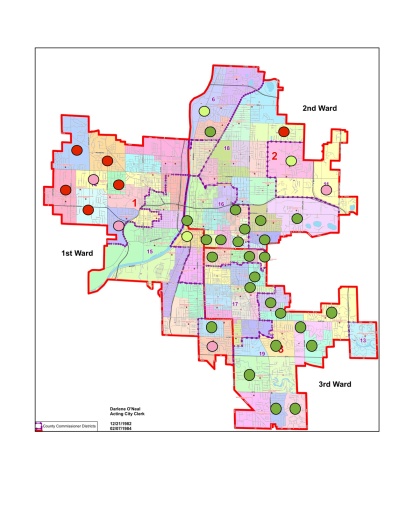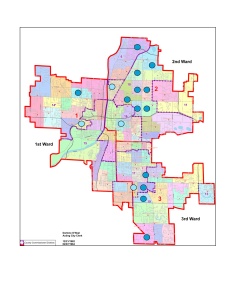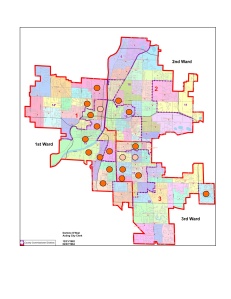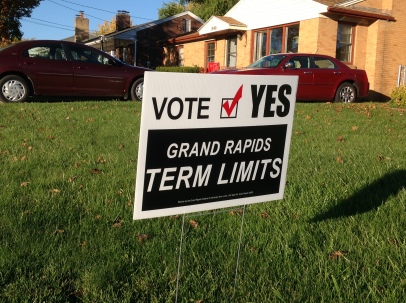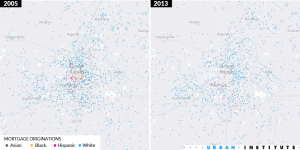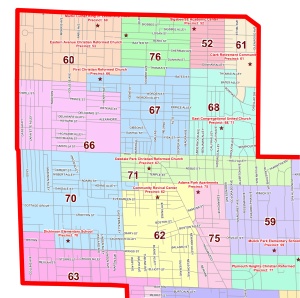On Tuesday, Grand Rapids voters will decided on a new city commissioner. And there’s a choice: one an activist, one a civic leader, and one out of her element. A month or more ago, it looked to be a fairly heated, even interesting race. As we turn towards the election, the race now looks somewhat bland, at least as the usual horse race goes. And for one, perhaps an opportunity lost.
But first, to review.
By all lights, Senita Lenear is the choice of the civic establishment. She has garnered support from a wide range of civic leaders, including both Democrats and Republicans. This fits her previous experience on the School Board where she earned a fair amount of credibility moving from the perception as a protege of Bernard Taylor to real independence in the post-Taylor period. As she explained to Wood-Tv, she was asked by the Mayor to consider running for the commission seat.
From her work with the school board she has earned the respect of the African American community. Being the wife of Dallas Lenear, one of the pastors at New Hope Baptist, certainly doesn’t hurt in this matter,either.
Her positions are what one might expect: use connections to lobby for the City, act with integrity (this poses a small question: who is it that is not acting with integrity on the Commission? — a vague sort of stance, actually), work with the budget, and in the Wood-Tv interview, address violence — particularly recent gang violence) that has been troubling the urban neighborhoods of the Ward. These are safe positions, consonant with the view of the City Commission as a civic board, and implicitly appealing to the alliance between the African-American community and the residual Dutch of the far suburbs. She’s safe.
In this context, Mike Tuffelmire is for all intents, the challenger. He is younger, a combat veteran and resident now in South Hills (originally from the Mulick Park / IHM neighborhood). His core base has been the new urbanist, local-business advocates that have revitalized East Hills, the Wealthy corridor and downtown. Key support also comes from Democrats, progressives, and the anti-Taylor cluster on the the school board. The support network is younger, more urban if not “Downtown” than Lenear’s. It can easily be misconstrued, as MLive did the other day, labeling Tuffelmire a “marijuana activist” for his work on the Grand Rapids Decriminalize campaign.
The campaign has focused on community engagement, on getting the neighborhoods heard. The campaign platform is more direct, concrete: stronger neighborhood representation, attention to violence (Tuffelmire separates violence into two categories: the direct violence of the core city neighborhoods, and the property crimes farther out), smarter budgeting, and attention to infrastructure along the business corridors. As with Lenear, these are positions that reflect his community.
Both are clearly competent and knowledgeable about the City. Both are likely to bring new perspectives to the City Commission. Yet this has been a surprisingly bland contest — how is that?
First, the neighborhood focus of both campaigns simply ignores the make up of the far ends of the Ward, out where the votes are. While in older neighborhoods (say pre-1950) there are strong identities and even associations, as one heads south of 28th, or east from Plymouth the character changes. These are largely suburban in layout and civic orientation. This is especially bad news for Tuffelmire, since the same suburban/civic orientation has these neighborhoods thinking in terms of Downtown, and general managerial competence — this is the strong suit for Lenear. These are also more reliably conservative in vote, another potential disadvantage for a more progressive candidate.
This is not to say it can’t be done, but only that if signs are any — or at least the first — indication, neither campaign has been especially successful in connecting.
Second, there is an absence of big picture vision in either campaign. How do we build a City that supports our neighborhoods? How will we engage in economic promotion? What will we do about our streets? Other infrastructure issues. Tuffelmire begins to get close to this; Lenear settles for pictures of the Calder (a nice subliminal touch) to indicate her Downtown sympathy.
Third, status quo issues. Here, the Tuffelmire campaign likely missed how much they were going to run as an insurgent. To be the alternative, one must make a critique of the present situation. Lenear’s presumptive role as successor is the barrier. Again, the diversity of the Ward enters in here: change for the better in the suburban neighborhoods (e.g. Ridgemoor, Shawnee, Sherwood Park, Ken-o-Sha to use the school names) will have a different feel than those who live in the core neighborhoods along Eastern, Kalamazoo or Wealthy.
Fourth, campaign experience. The Lenear campaign has experience, and a fluency in front of the camera. The number of supporters also means that networks can be leveraged. Tuffelmire has shown a greater facility with digital communications, but has not properly thought through the issues sufficient to make the case. A challenger campaign cannot afford to coast, it has to push. What is perhaps most distressing is the let-down after the Fourth. Whether it came from self-doubt, money, time the result was that mid-July there was a pause.
And Fifth, the missing. One of the most interesting aspects of the entire campaign has been the silence of certain communities. Neither campaign has shown any ability (or perhaps interest) in reaching into the old Dutch community. Although no longer as strong as it was a generation ago, the names are still important. Likewise, both campaigns have only a sprinkling of Hispanic names — again, this speaks to the limits of their own networks. And finally, there notable actors who are obviously interested in the outcome, but studiously neutral: the commissioners of the Second Ward (Rosalynn Bliss, Ruth Kelley), and the district’s other state representative, Winnie Brinks.
At this point, with the final weekend upon us, it would seem to be Lenear’s to lose.
Filed under: Community, Elections, Bernard Taylor, Mike Tuffelmire, MLive, Rosalynn Bliss, Ruth Kelley, Senita Lenear, Winnie Brinks
